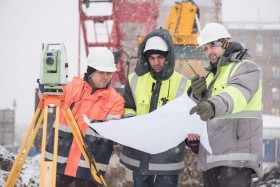Unsafe Working Conditions in the Cold

In a state like Michigan, the winter months really can be brutal. Some winters are colder and snowier than others, but even the years that aren’t so bad can still be pretty cold — especially if you have a job that involves working outside.
For industries that often involve working outside, winter doesn’t necessarily mean work completely comes to a halt until spring. Many landscaping professionals offer snow removal services to keep business going during the off season. Construction projects may still carry on. Utility workers still need to get out and make repairs and letter carriers still need to deliver the mail. And for those who are working outside during the winter months, that means having a new set of hazards to look out for.
Slips & Falls
Slip and fall accidents can happen at any time of year, but snow and ice can make them more likely to occur during the winter. Not only is there the risk of slipping and falling on the sidewalk or in parking lots, things like ladders and scaffolding can become very slippery during the day and it’s easy for people to fall when doing things like removing snow from roofs.
For employers, the best things they can do to prevent these kinds of accidents is to stay on top of removing snow and ice from parking lots, sidewalks, and other equipment used by workers. Also, make sure that everyone has appropriate safety gear for the job being worked on, such as boots with traction on the bottom. If snow needs to be removed from a roof or another structure, it’s best to use methods that don’t involve physically being on the roof if possible.
Driving
Car accidents are another type of accident that can happen at any time of the year, but bad weather can make roads particularly treacherous. There’s no way for employers to have control over the conditions on the road, but they can take steps to help make sure company-owned vehicles are prepared for winter weather. Before winter hits, it’s always a good idea to have vehicles inspected by a mechanic to make sure things like the engine, brakes and tires are in good shape, replace the windshield wiper blades, and to check that the vehicle’s oil and wiper fluid levels are good.
It’s also best to make sure vehicles are equipped with things like ice scrapers and an emergency kit stocked with things like flashlights, extra batteries, jumper cables, flares, blankets, and something to provide traction, such as sand or cat litter.
Cold Stress
Cold stress can take on three different forms: frostbite, hypothermia, and trench foot. Low temperatures and higher wind speeds can put people at an increased risk for all of these conditions.
Frostbite occurs when skin and its underlying tissues begin to freeze and most often impacts a body’s extremities, such as hands, fingers, feet, and toes. However, it also commonly occurs on other parts of the body which often aren’t covered by clothing, such as the nose, ears, and cheeks.When frostbite develops, it has the potential to cause permanent damage and in very severe cases, amputation may be needed.
Hypothermia occurs when a person’s body temperature drops below 95°F. Most commonly, it’s the result of spending too much time in the cold, but it can also happen in temperatures above 40°F if a person has been exposed to moisture, whether it’s rain, sweat, or physically getting into a body of cold water.
Trench foot is another condition that can be the result of exposure to water. Since wet feet lose heat 25x faster than dry feet, trench foot occurs when blood vessels contract to prevent heat loss, blocking oxygen from reaching the foot and causing skin tissue to begin to die. It doesn’t necessarily have to be cold for a person to develop trench foot, it’s been known to occur in temperatures as high as 60°F, but cold, winter temperatures can significantly raise the risk.
To prevent these kinds of problems, employers and employees should both be trained to know the symptoms to look for, how to prevent them, and what should be done if a person begins showing signs of cold stress. Employers should also take steps to protect workers from cold stress, such as by doing things like providing warming areas and making hot drinks available.
Even when temperatures are cold, employers still have a duty to provide a reasonably safe environment for people to work in. If you were injured on the job, contact an unsafe workplace lawyer as soon as possible. Dealing with workers’ comp and insurance can be very frustrating and a lawyer will be able to help make sure your case is handled correctly. At Goodwin & Scieszka, we’ve helped many people just like you. Contact us today to find out how we can help you.






